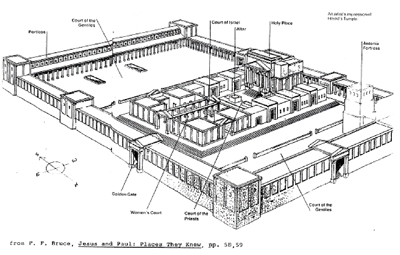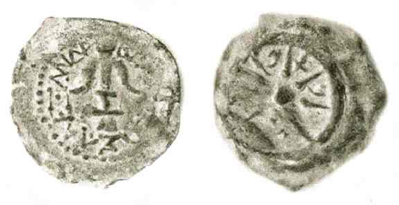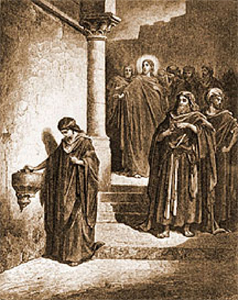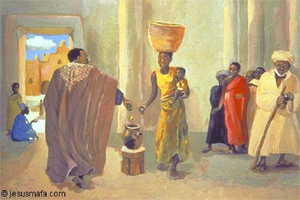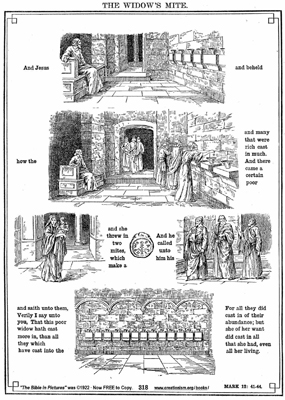
Christmas
Easter
Pentcoest
All Saints
Christ The King
Confirmation
Palm/Passion
Reformation
Stewardship
Books of the Bible
Lenten Series
Christmas Dramas
Videos
Series A - Matthew
Series B - Mark
Series C - Luke
Series D - Other
To contact
Edward F. Markquart
info@sfs.com
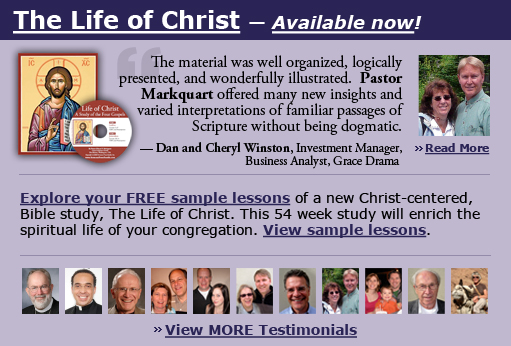
PENTECOST 23B GOSPEL ANALYSIS: HANNAH AND 2%Mark 12:38-44The following Bible study is from a larger course entitled, THE LIFE OF CHRIST: A Study in the Four Gospels. This 54 week course for the laity will be available for congregations in 2006. Basic text for the course: SYNOPSIS OF THE FOUR GOSPELS, Kurt Aland, English Edition, P. 139. The larger context of the story of the Widow's Mite: Jesus' teachigns against the religious leadership After the cleansing of the temple in the Jesus Narrative, there are several consecutive stories against the religious leadership. (SYNOPSIS OF THE GOSPELS, Aland, pp. 237-253)) The religious leadership consisted of the Pharisees, Sadducees, chief priests, scribes and others in authority. Each individual section needs to be read as part of the whole section. The teachings in this section are persistently against the religious leadership e.g. the Pharisees perceived that Jesus told this parable against them.
We remember that these religious leaders:
We recall the parable/teaching of The Fig Tree. For Jesus, the barren fig tree was leafy but had no fruit. The barren fig tree symbolized the Jewish religious leadership of Jesus’ day. These religious leaders talked a good religious talk and used all the right “buzz words” and clichés but did not put their words into actions in their daily lives. The fig tree symbolized the Pharisees who appeared healthy and leafy (like a fig tree) but produced no fruit of love. Today, this fig tree symbolizes any Christian who talks the talk but does not walk the walk. The apparently healthy fig tree without fruit symbolizes an apparently healthy Christian life that does not produce actions and behaviors that God wants from us. The tree looks healthy but it is not. A religious life looks healthy but it is not. A Christian can use all the right buzz words, read the Bible, attend church and do all the churchy things but lives a lie and does not demonstrate the love of Christ in daily actions. #285. Woe To The Scribes And Pharisees Matthew 23:1-36, Mark 12:37b-40, Luke 20:45-47 The following is from the Gospel of Mark: -And the large crowd was listening to him with delight. We can imagine how the large crowds loved the teachings of Jesus. We can imagine them delighting in the “fresh air” of Jesus’ words, especially compared to the dour cynicism of the Pharisees. -As he taught, he said, "Beware of the scribes, who like to walk around in long robes, and to be greeted with respect in the marketplaces, and to have the best seats in the synagogues and places of honor at banquets! The Gospel of Mark does not have the long set of “woes against the Pharisees” as Matthew does in Matthew 23. Instead, Mark lists these observations. In this text, there are five self-inflating behaviors of the scribes and Pharisees. Scribes were teachers and recorders of the Law of Moses.
-They devour widows' houses This statement is important because it sets up Jesus’ next story about the widow’s mite and her wonderful, moving act of selfless generosity. This statement is not parallel to the other five behaviors which are all done for the sake of appearances. A person wonders how they “devoured widow’s houses.” Were the Pharisees bankers of the day and foreclosed on widows and their meager assets? -and for the sake of appearance say long prayers. -They will receive the greater condemnation." When all is said, they will receive “the greater condemnation” by God at the last judgment. #286. The Widow's Mite Mark 12:41-33, Luke 21:1-4 In Mark’s gospel, the woes against the Pharisees are very brief, compared to the “woes” listed in Matthew’s gospel. But Jesus does say that the Pharisees “devoured the houses of widows.” The same phrase, “devoured the houses of widows,” is also used in Luke’s gospel. -He sat down opposite the treasury, and watched the crowd putting money into the treasury. Peter, being an eyewitness, gives us nice little details that accompany the story. We can imagine Jesus in the temple, opposite the treasury, sitting on the floor, and watching the people as they gave their offerings. From our Biblical studies, we have good maps, diagrams and reconstructions of the temple from the time of Jesus. Examine a drawing of the temple itself. From left to right, look at the blurry print and find: the porticoes, the Court of the Gentiles, the Court of Israel, Altar, Holy Place, Herod’s temple, Antonio Fortress. At the bottom of this drawing of the temple, from left to right, find the Golden Gate, Women’s Court, Court of the Priests, and Court of the Gentiles. Find the “Women’s Court.” This is where the treasury was located in Herod’s temple.
“In Herod's temple the name "treasury" was specially given to the "court of the women" (see TEMPLE, HEROD'S), where were 13 trumpet-shaped boxes for the reception of the offerings of the worshippers. It was here that Jesus saw the poor widow cast in her two mites (Mark 12:41; Luke 21:1-4), and the court is expressly named the "treasury" in John 8:20 : "These words spoke he in the treasury, as he taught in the temple." It is a legitimate deduction that this court was the ordinary scene of the Lord's ministry when teaching in the temple. -Many rich people put in large sums. Focus on the word, “rich.” The Gospel of Mark uses the word, “rich,” twice. Here and in Jesus’ teaching that “it is easier for a camel to go through the eye of a needle than someone who is rich to enter the kingdom of God.” Mark 10:25. How did Jesus know many rich people were putting in large sums of money? These rich people must have been doing something to communicate to a “people watcher” like Jesus that they were giving large sums of money. Jesus didn’t notice that ALL the rich people were doing this but MANY rich people were putting in large sums of money. In other words, certain rich people were putting in large sums of money “for the sake of appearance,” just as certain people wore long robes and said long prayers “for the sake of appearance.” We pastors chuckle as we read this line. As modern pastors, we are secretly and not so secretly hoping that “many rich people put in large sums” of money into the offering plates of our congregations. If not, there will be “trouble a brewing” when the church budget is short of cash and our congregation can’t pay all of its bills. As pastors, we don’t want to be “too hard on rich people.” We, pastors, of course, most often don’t think of ourselves as being rich but that the rich people in our parish are… “Well, we know who they are.” -A poor widow came and put in two small copper coins, which are worth a penny. The words “widow” and “poor” were intrinsically linked together in Jesus’ day and often today, especially in Third World, poorer nations. This poor woman had nothing except two copper coins and they were worth very little. Why were widows poor? Because the Old Testament laws of inheritance prevented her from receiving anything from her husband’s estate. The inheritance went to the oldest son. In the Old Testament, “widows and orphans” were often associated as people who experienced injustice. Both widows and orphans were the most vulnerable of people and society often ignored their needs. In the Greek language, these small copper coins were “lepton.” This was the smallest of Jewish coins. Just as a penny is the smallest coin within our American society today, so the lepton was the smallest coin in Jewish society of New Testament times.
“Widow's mite: bronze prutah of Jewish High Priest Alexander Jannaeus, showing anchor and star with Greek and Hebrew legends, BC 103-76.” -Then he called his disciples and said to them, ‘Truly I tell you, this poor widow has put in more than all those who are contributing to the treasury. Jesus saw to the heart of the issue. Jesus was always capable of reading the human heart. Jesus knew that this poor widow gave more than all the other peoples’ offerings combined. The value of her gift was not determined by its numerical size but what it represented: all that she had materially. -For all of them have contributed out of their abundance; That is the way it is for most of us American Christians. We give out of our abundance. -but she out of her poverty has put in everything she had, all she had to live on.’ This poor widow gave all she had. Everything. Nothing was left, except her belief that God will take care of her. It doesn’t seem to me that Jesus was criticizing the systemic injustice of Mosaic law which contributed to the economic poverty of widows and orphans. It doesn’t seem that Jesus was criticizing the generosity of the wealthy but was critical of those who were generous in order to get positive attention, respect and admiration (like wearing long robes and saying long prayers). It does seem that Jesus saw into the hearts of many rich people and this one poor widow. When all was said and done, Jesus knew that this poor widow gave everything she had. Jesus admired her and praised her, not because of her poverty, because out of her poverty, she gave everything she had. Jesus does not invite us to be like the widow in that we give everything we have to God. This is not a “sell ALL you have and give it to the poor” kind of passage that we expect to find in Luke’s gospel. Rather Jesus invites us to have inner hearts like this widow, who loved the Lord her God with all her heart, mind and soul. She gave all her being to God. She knew she was dependent on God for her next breath, her next meal, her next morning. She knew the truth about who she was…totally dependent on God for everything. It seems that we rich Americans can still learn some simple and basic lessons about life from poor people. Poor people often know more keenly than us rich folk about their need for God. When members of our congregation visit people from our sister church in Haiti, our rich folks come home to the USA from that “poorest of the poor” island with the deep impression that their Haitian brothers and sisters are totally dependent on God for everything in a way that we rich Americans are not. I constantly hear a refrain: “We have a lot to learn from our Haitian brothers and sisters. They are dependent on God in a way that we are not. They have something that we don’t have; a closeness to God, a reliance on God, a deep trust in God who will care for them in all circumstances. Plus, there is a happiness that radiates from them even when they are so materially poor. Go figure that one out.” Yes, poor widows from Jesus’ day and today are still teaching us about our need for and dependence on God for all things. -And as he came out of the temple (Mark 13:1) This ends the section of Jesus’ teachings in the temple against the Pharisees. PAINTING AND IMAGINATION: THE WIDOW’S MITE http://www.ewtn.com/gallery/tnt/nt8s.htm
http://www.jesusmafa.com/anglais/imag49.htm
Good pictorial sequence of the story of the widow’s mite:
|
|
